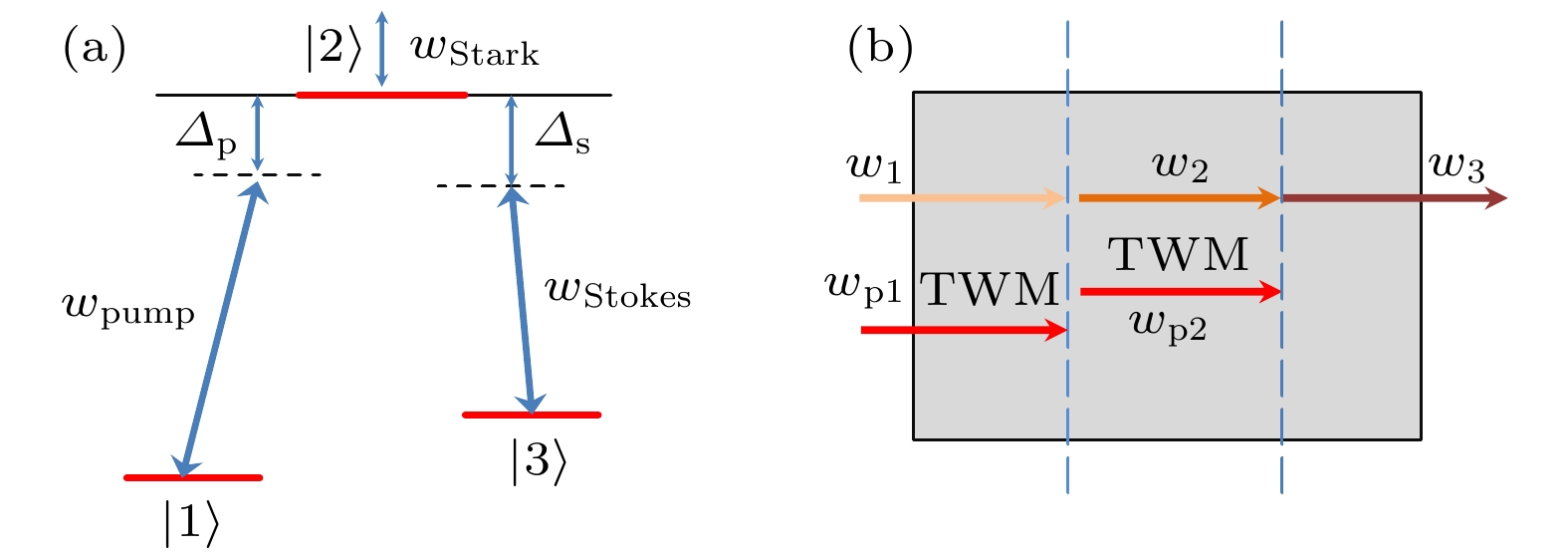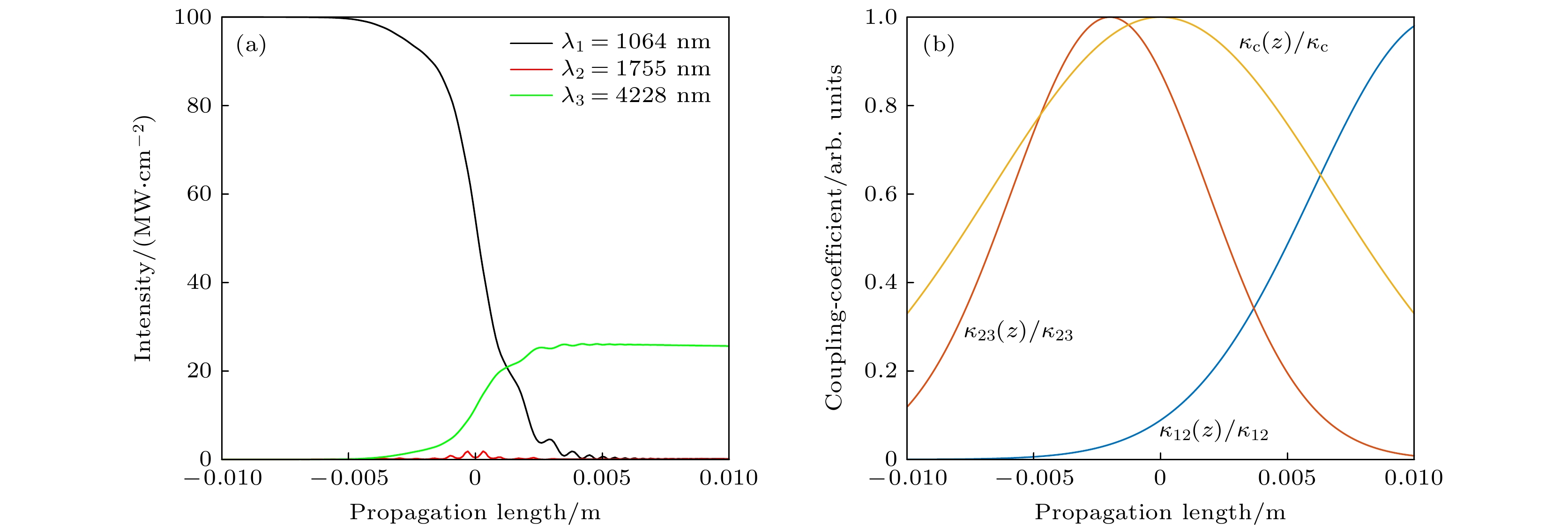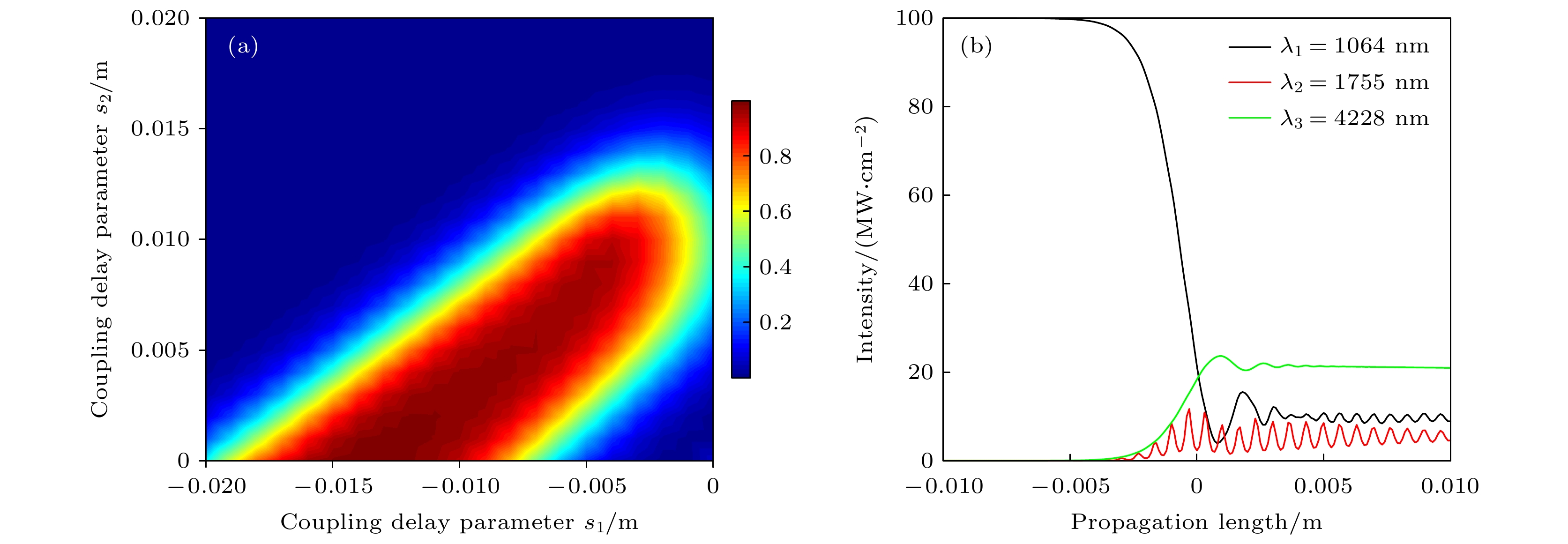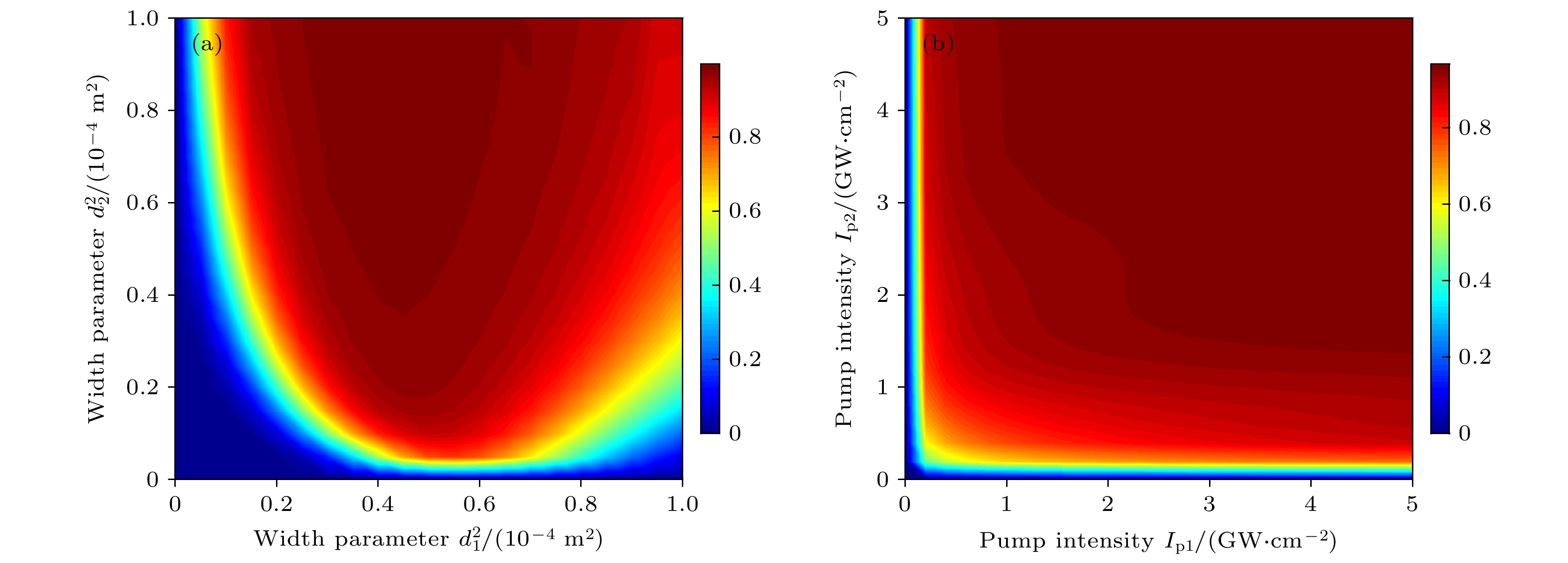-
通过近似类比原子绝热布居理论, 建立了基于KTP晶体的斯塔克啁啾快速绝热通道理论的波长转换模型, 系统研究了晶体耦合调制中的耦合迟延参数和宽度参数、泵浦强度、温度、入射波长等因素对转换效率的影响. 结果表明在KTP晶体中能实现入射光能量到出射光能量近乎完全的转换, 同时转换过程中中间光能量保持极低. 离最优晶体耦合调制参数越远, 转换效率越低. 转换效率先随泵浦强度的增大不断增大, 当转换效率达到最大值, 增大泵浦强度对转换效率几乎无影响. 温度和入射波长的变化对转换效率影响较小. 研究结果表明基于KTP晶体的斯塔克啁啾快速绝热通道理论的波长转换具有很好的鲁棒性. 该研究可为紫外到中红外光源的获取以及光子器件的制造提供理论依据.
-
关键词:
- KTP晶体 /
- 斯塔克啁啾快速绝热通道 /
- 波长转换
The nonlinear wavelength conversion can generate the laser wavelengths which are not directly available, thereby broadening the laser spectrum range. However, the phase mismatch greatly limits the development and application of nonlinear optical technology. The wavelength conversion schemes in a manner analogous to population transfer in atomic rapid adiabatic passage, stimulated Raman adiabatic passage (STIRAP), and Stark chirped rapid adiabatic passage (SCRAP) provide feasible solutions for efficient and broadband wavelength conversion. The SCRAP uses the Stark shift caused by the Stark field to generate energy level crossings, therefore, the population in initial state can be efficiently converted into the target state. It does not require the two-photon resonance, and can be applied to multi-photon transition. In this paper, by approximate analogy to the adiabatic population theory, a wavelength conversion model with the KTP crystals based SCRAP is established, the influence of the coupling delay parameters, width parameters, pump intensity, temperature, and incident wavelength on the conversion process are systematically studied. The results show that the signal laser energy can be almost converted into output laser energy, while the intermediate laser energy is kept extremely low in the conversion process. The conversion process is sensitive to changes in coupling delay parameters, width parameters, and pump intensity. The farther away fromits optimal value the coupling delay parameter, the lower the conversion efficiency is. When the width parameter$ d_2^2 $ is fixed, as the width parameter$ d_1^2 $ increases, the conversion efficiency first increases to a maximum value, and then slowly decreases. At the same time, the greater the value of the width parameter$ d_2^2 $ , the greater the achievable maximum conversion efficiencies, and the greater the bandwidth that can achieve high-efficiency wavelength conversion. The conversion efficiency increases as the pump intensity increases. When the conversion efficiency value reaches a maximum value, the increase in pump intensity has almost no effect on the conversion efficiency. However, changes in temperature and incident wavelength have little effect on the conversion efficiency. The above research can provide a theoretical basis for the acquisition of ultraviolet to mid-infrared light sources and the manufacture of photonic devices.[1] Stolen R H, Bjorkholm J E, Ashkin A 1974 Appl. Phys. Lett. 24 308
 Google Scholar
Google Scholar
[2] Chang J H, Mao Q H, Feng S J, Gao X M, Xu C Q 2010 Opt. Lett. 35 3486
 Google Scholar
Google Scholar
[3] Zhong H Z, Zhang L F, Li Y, Fan D Y 2015 Sci. Rep. 5 10887
 Google Scholar
Google Scholar
[4] Margules P, Moses J, Suchowski H, Porat G 2021 J. Phys. Photonics 3 022011
 Google Scholar
Google Scholar
[5] Sasaki Y, Yuri A, Kawase K, Ito H 2002 Appl. Phys. Lett. 81 3323
 Google Scholar
Google Scholar
[6] Huang J T, Rao Z M, Xie F S 2019 Opt. Express 27 17199
 Google Scholar
Google Scholar
[7] Li Y Y, Yesharim O, Hurvitz I, Karnieli A, Fu S H, Porat G, Arie A 2020 Phys. Rev. A 101 033807
 Google Scholar
Google Scholar
[8] Chen B Q, Zhang C, Hu C Y, Liu R J, Li Z Y 2015 Phys. Rev. Lett. 115 083902
 Google Scholar
Google Scholar
[9] Chen B Q, Hong L H, Hu C Y, Zhang C, Liu R J, Li Z Y 2018 J. Opt. 20 034009
 Google Scholar
Google Scholar
[10] Suchowski H, Oron D, Arie A, Silberberg Y 2008 Phys. Rev. A 78 063821
 Google Scholar
Google Scholar
[11] Ding X Y, Heberle D, Harrington K, Flemens N, Chang W Z, Birks T A, Moses J 2020 Phys. Rev. Lett. 124 153902
 Google Scholar
Google Scholar
[12] Ding X Y, Habib M S, Amezcua-Correa R, Moses J 2019 Opt. Lett. 44 1084
 Google Scholar
Google Scholar
[13] Bahar E, Ding X Y, Dahan A, Suchowski H, Moses J 2018 Opt. Express 26 25582
 Google Scholar
Google Scholar
[14] Mrejen M, Erlich Y, Levanon A, Suchowski H 2020 Laser Photonics Rev. 14 2000040
 Google Scholar
Google Scholar
[15] Porat G, Arie A 2012 J. Opt. Soc. Am. B 29 2901
 Google Scholar
Google Scholar
[16] Porat G, Silberberg Y, Arie A, Suchowski H 2012 Opt. Express 20 3613
 Google Scholar
Google Scholar
[17] Rickes T, Marangos J P, Halfmann T 2003 Opt. Commun. 227 133
 Google Scholar
Google Scholar
[18] Oberst M, Klein J, Halfmann T 2006 Opt. Commun. 264 463
 Google Scholar
Google Scholar
[19] Wang T F, Li J F, Zhou W H, Chen C S 2018 Appl. Phys. Express 11 122202
 Google Scholar
Google Scholar
[20] Wang T F, Wan T, Zhou W H, Chen C S 2019 J. Opt. Soc. Am. B 36 1958
 Google Scholar
Google Scholar
[21] Rangelov A A, Vitanov N V, Yatsenko L P, Shore B W, Halfmann T, Bergmann K 2005 Phys. Rev. A 72 053403
 Google Scholar
Google Scholar
[22] Yatsenko L P, Shore B W, Halfmann T, Bergmann K, Vardi A 1999 Phys. Rev. A 60 R4237
 Google Scholar
Google Scholar
[23] Viedma D, Ahufinger V, Mompart J 2021 Opt. Express 29 39200
 Google Scholar
Google Scholar
[24] Vitanov N V, Rangelov A A, Shore B W, Bergmann K 2017 Rev. Mod. Phys. 89 015006
 Google Scholar
Google Scholar
[25] Mizuuchi K, Yamamoto K, Kato M, Sato H 1994 IEEE J. Quantum Electron. 30 1596
 Google Scholar
Google Scholar
[26] Guo H C, Tang S H, Qin Y Q, Zhu Y Y 2005 Phys. Rev. E 71 066615
 Google Scholar
Google Scholar
[27] Wei J X, Chen C S 2013 Opt. Commun. 311 380
 Google Scholar
Google Scholar
[28] Wei J X, Chen C S, Jiang H, Li W, Han T 2013 Phys. Rev. A 88 023806
 Google Scholar
Google Scholar
[29] Sun C, Chen C S, Wei J X, Li P P 2014 IEEE Photon. J. 6 6100607
[30] Xu L, Chen C S, Zhao X Y, Liu T, Hu H 2015 Laser Phys. 25 125404
 Google Scholar
Google Scholar
[31] Li F J, Zhang Z H, Wan T, Zhang H D, Chen C S 2022 Opt. Commun. 502 127427
 Google Scholar
Google Scholar
[32] Shur V Y, Pelegova E V, Akhmatkhanov A R, Baturin I S 2016 Ferroelectrics 496 49
 Google Scholar
Google Scholar
[33] Suchowski H, Porat G, Arie A 2014 Laser Photonics Rev. 8 333
 Google Scholar
Google Scholar
[34] Chou M H, Parameswaran K R, Fejer M M, Brener I 1999 Opt. Lett. 24 1157
 Google Scholar
Google Scholar
[35] Chen X F, Wu F, Zeng X L, Chen Y P, Xia Y X, Chen Y L 2004 Phys. Rev. A 69 013818
 Google Scholar
Google Scholar
[36] Reshak A H, Kityk I V, Auluck S 2010 J. Phys. Chem. B 114 16705
 Google Scholar
Google Scholar
[37] Hu X P, Xu P, Zhu S N 2013 Photonics Res. 1 171
 Google Scholar
Google Scholar
-
图 3 (a)耦合迟延参数对转换效率的影响; (b)耦合迟延参数为
$ {s_1} $ = –0.011 m,$ {s_2} $ = 0.006 m时三波长强度随传播长度的变化情况Fig. 3. (a) The conversion efficiency as a function of the coupling delay parameters; (b) the three wavelengths vary with propagation length when the coupling delay parameters are
$ {s_1} $ = –0.011 m,$ {s_2} $ = 0.006 m.图 4 (a)宽度参数
$ d_1^2 $ ,$ d_2^2 $ 对转换效率的影响; (b)泵浦强度$ {I_\text{p1}} $ ,$ {I_\text{p2}} $ 对转换效率的影响Fig. 4. (a) The conversion efficiency as a function of the width parameters
$ d_1^2 $ and$ d_2^2 $ ; (b) the conversion efficiency as a function of the pump intensities$ {I_\text{p1}} $ and$ {I_\text{p2}} $ . -
[1] Stolen R H, Bjorkholm J E, Ashkin A 1974 Appl. Phys. Lett. 24 308
 Google Scholar
Google Scholar
[2] Chang J H, Mao Q H, Feng S J, Gao X M, Xu C Q 2010 Opt. Lett. 35 3486
 Google Scholar
Google Scholar
[3] Zhong H Z, Zhang L F, Li Y, Fan D Y 2015 Sci. Rep. 5 10887
 Google Scholar
Google Scholar
[4] Margules P, Moses J, Suchowski H, Porat G 2021 J. Phys. Photonics 3 022011
 Google Scholar
Google Scholar
[5] Sasaki Y, Yuri A, Kawase K, Ito H 2002 Appl. Phys. Lett. 81 3323
 Google Scholar
Google Scholar
[6] Huang J T, Rao Z M, Xie F S 2019 Opt. Express 27 17199
 Google Scholar
Google Scholar
[7] Li Y Y, Yesharim O, Hurvitz I, Karnieli A, Fu S H, Porat G, Arie A 2020 Phys. Rev. A 101 033807
 Google Scholar
Google Scholar
[8] Chen B Q, Zhang C, Hu C Y, Liu R J, Li Z Y 2015 Phys. Rev. Lett. 115 083902
 Google Scholar
Google Scholar
[9] Chen B Q, Hong L H, Hu C Y, Zhang C, Liu R J, Li Z Y 2018 J. Opt. 20 034009
 Google Scholar
Google Scholar
[10] Suchowski H, Oron D, Arie A, Silberberg Y 2008 Phys. Rev. A 78 063821
 Google Scholar
Google Scholar
[11] Ding X Y, Heberle D, Harrington K, Flemens N, Chang W Z, Birks T A, Moses J 2020 Phys. Rev. Lett. 124 153902
 Google Scholar
Google Scholar
[12] Ding X Y, Habib M S, Amezcua-Correa R, Moses J 2019 Opt. Lett. 44 1084
 Google Scholar
Google Scholar
[13] Bahar E, Ding X Y, Dahan A, Suchowski H, Moses J 2018 Opt. Express 26 25582
 Google Scholar
Google Scholar
[14] Mrejen M, Erlich Y, Levanon A, Suchowski H 2020 Laser Photonics Rev. 14 2000040
 Google Scholar
Google Scholar
[15] Porat G, Arie A 2012 J. Opt. Soc. Am. B 29 2901
 Google Scholar
Google Scholar
[16] Porat G, Silberberg Y, Arie A, Suchowski H 2012 Opt. Express 20 3613
 Google Scholar
Google Scholar
[17] Rickes T, Marangos J P, Halfmann T 2003 Opt. Commun. 227 133
 Google Scholar
Google Scholar
[18] Oberst M, Klein J, Halfmann T 2006 Opt. Commun. 264 463
 Google Scholar
Google Scholar
[19] Wang T F, Li J F, Zhou W H, Chen C S 2018 Appl. Phys. Express 11 122202
 Google Scholar
Google Scholar
[20] Wang T F, Wan T, Zhou W H, Chen C S 2019 J. Opt. Soc. Am. B 36 1958
 Google Scholar
Google Scholar
[21] Rangelov A A, Vitanov N V, Yatsenko L P, Shore B W, Halfmann T, Bergmann K 2005 Phys. Rev. A 72 053403
 Google Scholar
Google Scholar
[22] Yatsenko L P, Shore B W, Halfmann T, Bergmann K, Vardi A 1999 Phys. Rev. A 60 R4237
 Google Scholar
Google Scholar
[23] Viedma D, Ahufinger V, Mompart J 2021 Opt. Express 29 39200
 Google Scholar
Google Scholar
[24] Vitanov N V, Rangelov A A, Shore B W, Bergmann K 2017 Rev. Mod. Phys. 89 015006
 Google Scholar
Google Scholar
[25] Mizuuchi K, Yamamoto K, Kato M, Sato H 1994 IEEE J. Quantum Electron. 30 1596
 Google Scholar
Google Scholar
[26] Guo H C, Tang S H, Qin Y Q, Zhu Y Y 2005 Phys. Rev. E 71 066615
 Google Scholar
Google Scholar
[27] Wei J X, Chen C S 2013 Opt. Commun. 311 380
 Google Scholar
Google Scholar
[28] Wei J X, Chen C S, Jiang H, Li W, Han T 2013 Phys. Rev. A 88 023806
 Google Scholar
Google Scholar
[29] Sun C, Chen C S, Wei J X, Li P P 2014 IEEE Photon. J. 6 6100607
[30] Xu L, Chen C S, Zhao X Y, Liu T, Hu H 2015 Laser Phys. 25 125404
 Google Scholar
Google Scholar
[31] Li F J, Zhang Z H, Wan T, Zhang H D, Chen C S 2022 Opt. Commun. 502 127427
 Google Scholar
Google Scholar
[32] Shur V Y, Pelegova E V, Akhmatkhanov A R, Baturin I S 2016 Ferroelectrics 496 49
 Google Scholar
Google Scholar
[33] Suchowski H, Porat G, Arie A 2014 Laser Photonics Rev. 8 333
 Google Scholar
Google Scholar
[34] Chou M H, Parameswaran K R, Fejer M M, Brener I 1999 Opt. Lett. 24 1157
 Google Scholar
Google Scholar
[35] Chen X F, Wu F, Zeng X L, Chen Y P, Xia Y X, Chen Y L 2004 Phys. Rev. A 69 013818
 Google Scholar
Google Scholar
[36] Reshak A H, Kityk I V, Auluck S 2010 J. Phys. Chem. B 114 16705
 Google Scholar
Google Scholar
[37] Hu X P, Xu P, Zhu S N 2013 Photonics Res. 1 171
 Google Scholar
Google Scholar
计量
- 文章访问数: 6038
- PDF下载量: 70
- 被引次数: 0


















 下载:
下载:
















